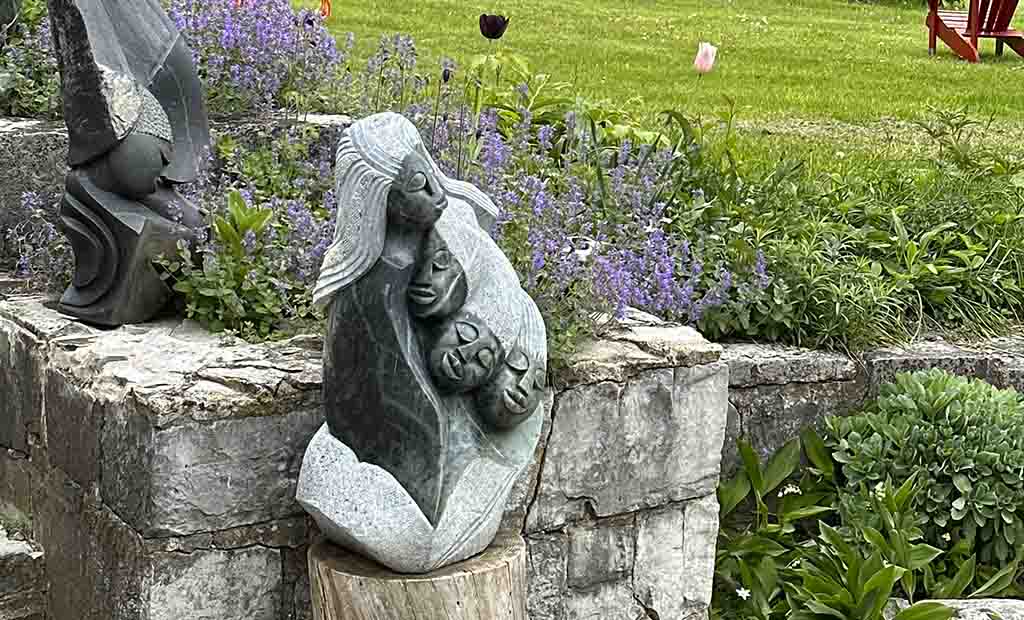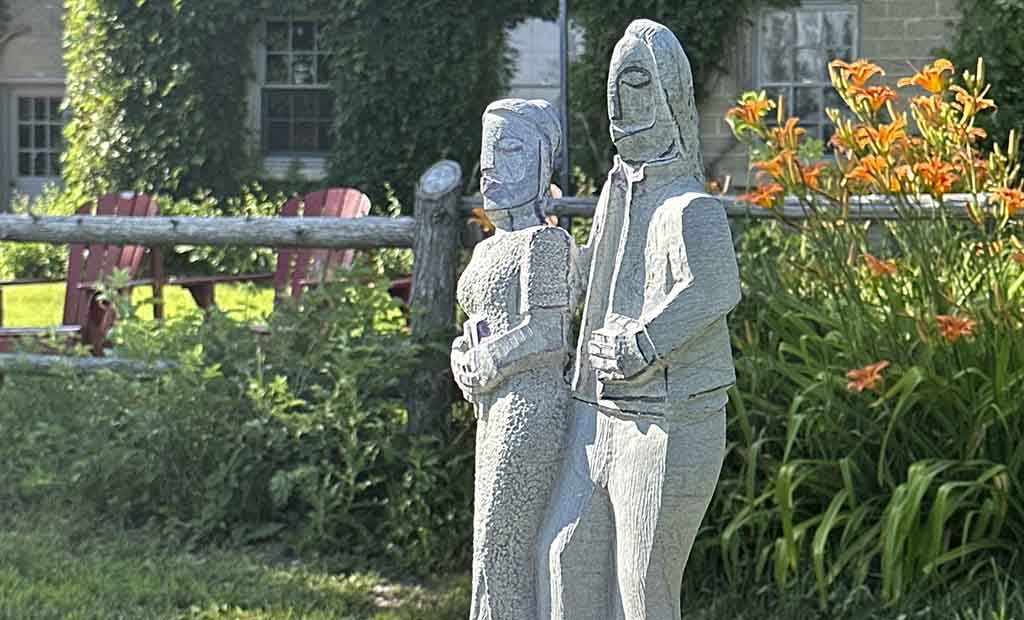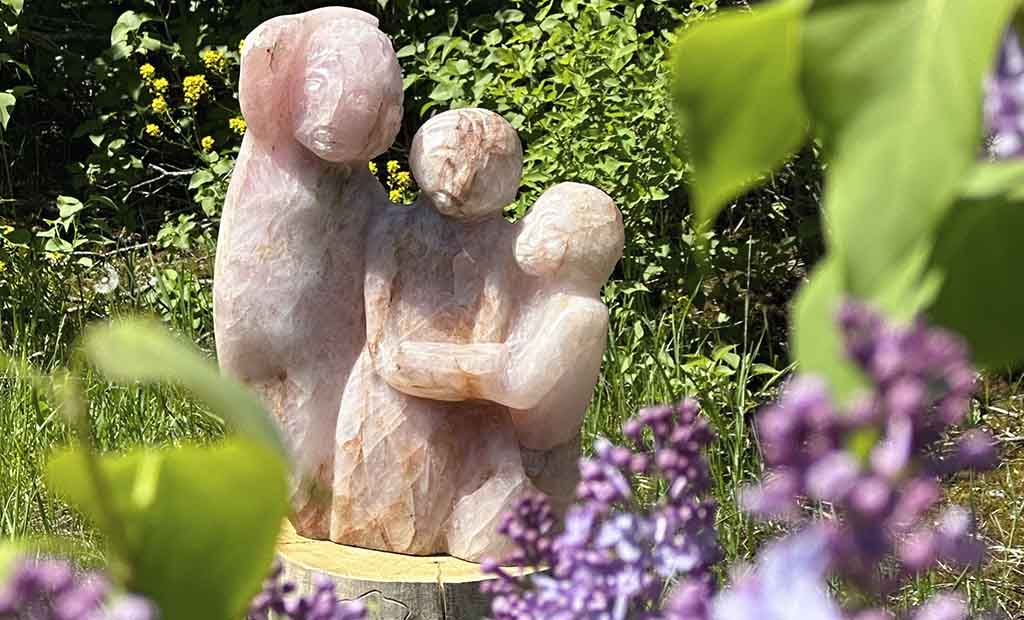Over the past three years I have watched something interesting and unusual take shape on the Ontario art scene. Gunguo Sculpture Farm is a remarkable new open-air gallery in Glenburnie, Kingston. Once Canada’s first capital, Kingston is perhaps known more for its picturesque downtown university, historic prisons and forts, than its avantgarde art scene. It is a labor of love of anthropologist William Suk and hematologist Gillian Kupakuwana, a married couple from Zimbabwe and Canada who met as high school exchange students and now joke about themselves as being “doctors with borders.”
Arriving at Gunguo is a magical experience, as if entering a Georgian fairytale complete with gnarled apple trees, sprawling lilac gardens, forsythia and hydrangea. One almost expects an elf or dryad to peep out from behind the limestone cottage and attached stables. This quintessentially Kingstonian farmstead was built during the 1840s, by Irish and Scottish immigrants. Canadian antiquities decorate the walls of the intimate indoor gallery, while remnants of horse-drawn farming implements adorn the sculpture trail. When combined with the most exquisite gemstone carvings from Zimbabwe, it is an unexpected and unique experience.
Upon arrival, visitors are greeted by a gallerist or visiting artist who leads a short tour into the lilac labyrinth which is especially vibrant in May. The easy-walking, two kilometer trail meanders around the farmhouse, by the barn and through the gardens. Benches and tables are scattered throughout so visitors may enjoy a picnic or a leisurely conversation with their friends. Several sculpture placements exhibit work from Zimbabwe where Gillian is originally from. Zimbabwe is known throughout the world for its ancient stone carving tradition typically described as “Shona Sculpture.” After thousands of years of history, this practice still thrives and actually supplies a large portion of the world’s stone carvings through numerous international galleries. (One of which was the much-loved ZimArt Gallery in Rice Lake near Peterborough which closed in 2023 after twenty years of exhibiting the finest African art in Ontario.) The traveling exhibition ZimSculpt has brought high-profile shows to Toronto’s Botanical Gardens and Burlington’s Royal Botanical Gardens.

William and Gillian’s operation is still in the startup phase, lacking the larger-than-life statement pieces that Zimbabwe is famous for. But what Gunguo lacks in size, it makes up for in enthusiasm, vision, and dare I say, innovation.
I recall viewing dazzling exhibitions at the Chelsea Flower Show since the days of Zimbabwe’s independence struggle–and as a young art lover in the 1970s I remember a huge buzz around the show at the Institute of Contemporary Arts in London. William and Gillian’s collection is admittedly more humble, but an experienced eye picks up on one or two interesting developments.
Specifically, Gunguo exhibits what is claimed to be the world’s largest collection of Zimbabwean gemstone sculpture. Here “gemstones” are considered as a class of vividly-coloured, semi-precious quartzites including red “bwedzvuku” jasper, rose quartz, petrified wood and banded blue agate. These stones fracture when struck with a chisel and can only be carved with expensive modern tooling and diamond abrasives. In the early days of Shona sculpture’s arrival in Europe and North America there was a rejection of the use of machines and a preference for the mystique of hand tooling. Carving gemstones, it turns out, requires embracing a medium that can only be shaped with the electrically powered equipment, that the sculpture industry historically scorned.
Gunguo’s impressive gemstone collection is largely a product of the “Simukai” residency which was William and Gillian’s first foray into the art industry. In 2017 and 2018 the duo equipped a world-class sculpture facility in Zimbabwe. They gathered a supply of raw gemstones and invited their favorite artists from around the country to spend a couple of weeks at a time experimenting with these new tools and materials. COVID put an untimely end to this art incubator, but gemstone carving is quickly gaining prominence in Zimbabwe’s sculpture scene. This is for good reason–gemstone sculptures are brilliant, as awe-inspiring under natural sunlight as they are in a garden setting, and they grab attention on social media. The Simukai collection comprises many of the earliest pieces in this contemporary offshoot of Zimbabwe’s ancient stone carving tradition: reason enough for sculpture aficionados to make the day-trip to Gunguo from Toronto, Ottawa, or Montreal which are all equidistant from the gallery.

As for vision, Gunguo represents the ambitious attempt of a border-straddling Canadian family to make their mark on the contemporary art scene. William and Gillian speak enthusiastically about reaching out to Canadian sculptors this year and even envision landscape-scale installations by local and international artists as their project matures. In my opinion, an afternoon at Gunguo is already as appealing as the best establishments between Oeno Gallery in Prince Edward County and Storm King outside New York City. Plus it has a sort of “undiscovered” vibe.
Above all, William and Gillian are motivated by the belief that art can be a starting point for cross-cultural communication and even understanding. “We are from totally different worlds,” William explains, “Gillian literally grew up under apartheid in Africa, while I had a free-range childhood in the Dutch-immigrant suburbs of southern Ontario and Grand Rapids Michigan–which was pretty much the same thing, though I didn’t really think about it at the time.”
He goes on to recount how the couple got into collecting: “beginning on our honeymoon when we acquired our first sculpture, art became something that helped us bridge this international divide. Each piece we collected became a launching point for discussions about Zimbabwean mythology, for example, or history. Then we would try to relate it to our situation in a totally different context. For us, art was always a conversation starter, and that’s what we want to manifest in the world through Gunguo.” It is difficult not to be inspired by this inclusive and hopeful vision which sometimes seems under threat these days.
Gillian and William set up the sculpture farm a bit differently than most other commercial galleries. Viewings are by appointment only. Tickets may be purchased in advance via the website, although same-day purchases and last-minute rescheduling is allowed, provided that tickets are still available. “We had several hundred visitors last year,” Gillian declared, “and this year we hope to double that number in the twelve weeks that we are open.” Visitors are encouraged to dress for the weather, and to wear closed shoes and long pants. “I encourage people to bring painting materials and picnics” Gillian says, “or maybe enjoy their favorite beverage at one of the bistro tables.”
It really is a lovely gathering place, a perfect location to linger, meditate or gossip. Gunguo Sculpture Farm may be in its early stages, but something tells me it is a gallery to keep an eye on.
Open May 9 – Aug 2. Hours vary by day. Book in advance at https://sculpturefarm.ca. Use code GRAPEVINE for $10 off. Consider an early morning or evening booking. Same-day bookings available online.



